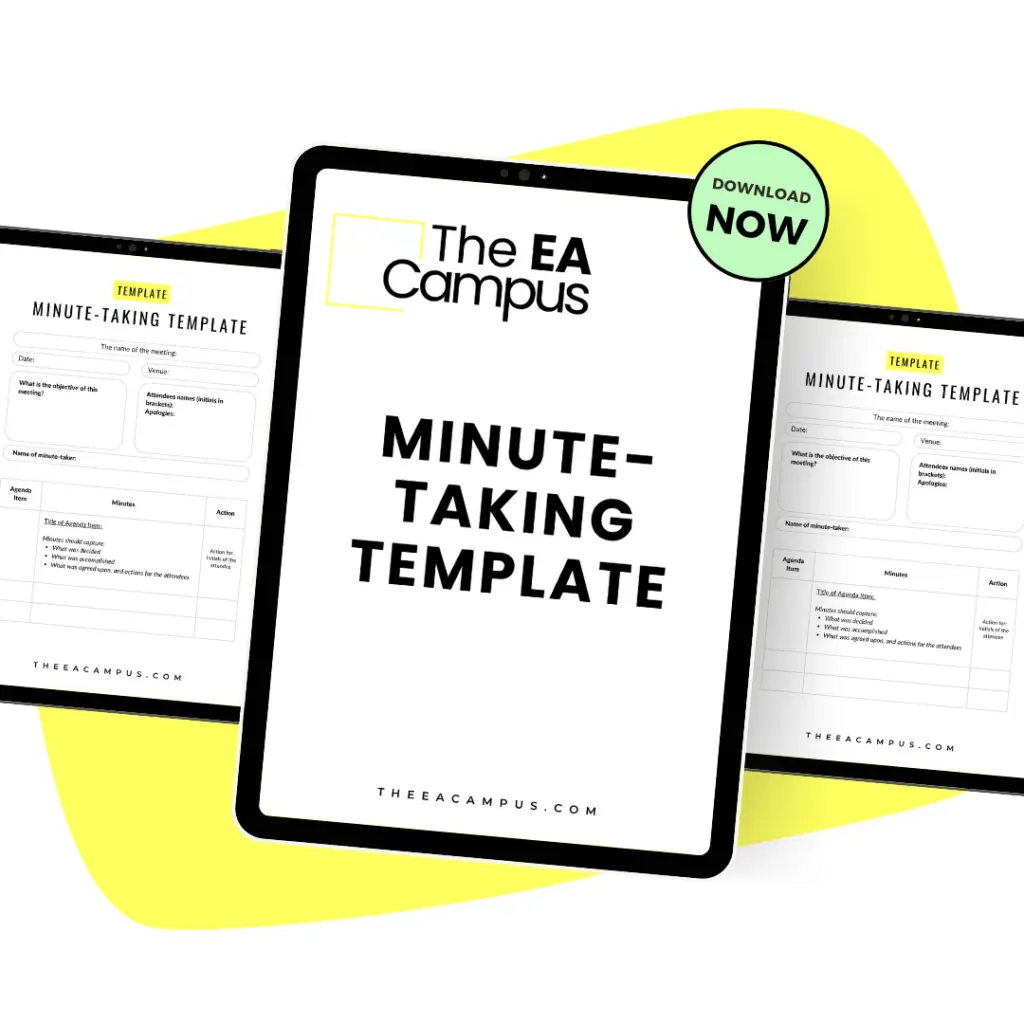Writing minutes is an essential skill for Executive Assistants. This ultimate guide to effective minute-taking will break down everything Executive Assistants need to know to create minutes that will be read and actioned, teaching you effective minute-taking techniques.
A few years back, I had a job that provided support for twelve committees that had four meetings a year, which meant I wrote a set of minutes practically every week. As you can imagine, I got pretty good at writing minutes without much thought, but no matter how comfortable I found the process, it still took a long time.
I soon realized that thoughtful preparation was required to write a comprehensive set of minutes. Simply typing out what I had written down wouldn’t make the task any less arduous.
In this ultimate guide, we will provide Executive Assistants with tips and tools to create effective minutes, including:

This simple template is designed to help busy Assistants take effective minutes. It’s easy to use and comes preloaded with useful features tailored to minute-taking at board meetings.
Whether minuting interviews, team meetings or executive leadership committees, this template helps you record everything accurately and professionally.
So, for all of you who write minutes for meetings, don’t enjoy it, and take forever to complete the work, here are eleven minute-taking best practices that will help you get them finished, circulated, and out of your to-do tray as quickly as possible while still producing quality work.
A minute taker needs to be fully engaged and listening 100 percent of the time. While recording meetings with technology has become much easier, minute-takers still play a crucial role, especially for official board meetings and highly confidential discussions where recording may not be appropriate or allowed.
Minute takers must be confident enough to speak up during a meeting (when appropriate) to clarify points. Having the confidence to ask questions ensures that the minutes are accurate and comprehensive.
While it might be tempting to delay finalizing notes, it’s best to get them into a publishable format as soon as possible, ideally by the next day. Even if you are skilled at drafting minutes, memory can fade, and notes can become unclear. Quick turnaround also serves as an early reminder for those with action items, reducing the time you spend following up before the next meeting.
Preparation is key. Arrive at the meeting having read the agenda, background papers, and minutes from the previous session. Bring all necessary tools for taking minutes, such as a pen, highlighter, paper, recording device, laptop, or tablet. Always have a backup pen or digital device.
When taking minutes, focus on capturing the main points of the discussion, decisions made, and action items. Avoid documenting every detail or using “he said, she said” language. Focus instead on the essential outcomes of the meeting.
Remain neutral in your notes. Even if tensions arise or debates become heated, your minutes should remain unbiased and factual. If directed by the Chairperson to include sensitive details, maintain a neutral tone and choose your vocabulary carefully.
Using varied and descriptive language can make your minutes more readable and engaging. If you find yourself repeating the same phrases, consider expanding your vocabulary. The EA Campus offers a cheat sheet of 100 descriptive words to help diversify your minute-taking. Download the cheat sheet here.
Understanding the context of the meeting topics can make it much easier to write minutes. Read all supporting papers beforehand and, if necessary, ask the Chairperson for a brief overview. During the meeting, focus on listening and summarizing rather than transcribing verbatim.
Minutes should be written in the past tense and third person. For example, “Nicky Christmas agreed to distribute the minutes as soon as possible.” Using initials rather than full names can save time, but this may depend on your organization’s style preferences.
There’s no need to include information already covered in distributed reports or documents. Simply note that “the report was reviewed” and summarize any action points or key discussions that followed.
Proofreading is essential to ensure your minutes are accurate and polished. After drafting, take a break and then review your work with fresh eyes. Expect that your minutes may be reviewed and edited by others before final distribution.
Modern technology offers a range of tools that can simplify the minute-taking process. Here are some up-to-date solutions:
Executive Assistants are asked to perform a wide range of tasks, and at some point, nearly every Assistant will be tasked with writing minutes. Love them or hate them, minute-taking is here to stay!
Meetings remain a vital part of business, and actions must be accurately captured. To help you with effective minute-taking, here’s a straightforward template you can use for any set of minutes:
This is an excellent tip for minute-taking beginners. Remember that minutes should capture the three points below – nothing more, nothing less:
The format of your minutes should be consistent. Ideally, you should work with a single template. If your company doesn’t have a branded template, suggest creating one with your Executive. A simple Word template with the following information will suffice:
We hope this article helps you with effective minute-taking. Remember to download our 100-word cheat sheet, and check out our articles on board meeting management and creating the perfect agenda.
Minute-taking is an essential skill for Executive Assistants and can significantly enhance your career. Effective minute-taking strategies ensure that your minutes are clear, concise, and accurate. Additionally, many important decisions are based on meeting minutes, making accurate record-keeping critical.
If you want to further develop your minute-taking skills, consider enrolling in the Assistant Essentials online course from The EA Campus. Here, you’ll gain valuable insights into minute-taking and other essential skills for Executive Assistants.
Share this article:
Join 30,000+ Assistants receiving our carefully crafted weekly newsletter packed with valuable tips, tricks, and insights tailored specifically for Assistants like you.